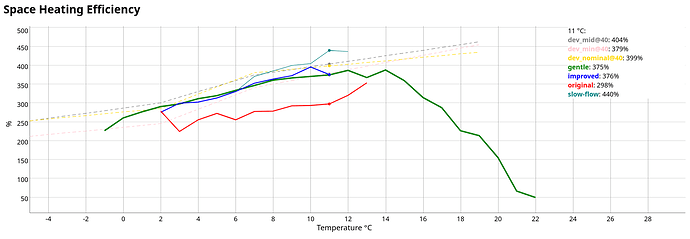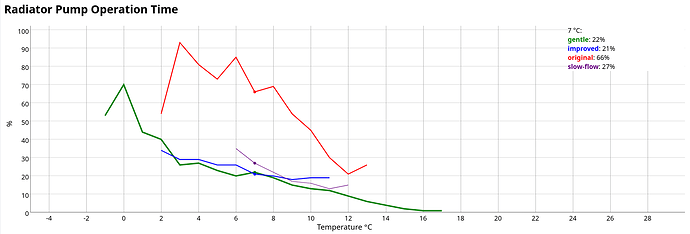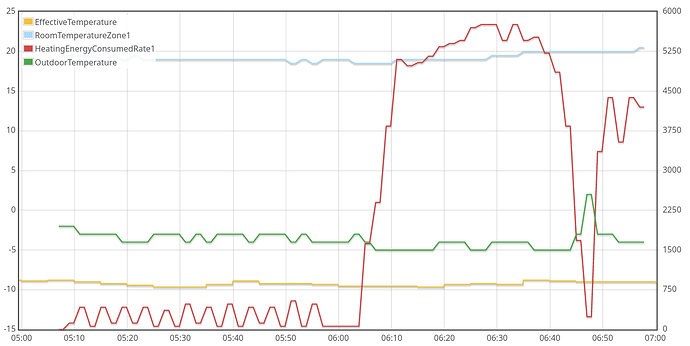Hi,
I have just got the monitoring system working on our Mitsubishi Ecodan air source heat pump, and am getting my head around all the lovely data.
I was surprised to see that the circulation pump (which uses 150W) seems to run whenever the outside air temp falls below about 8 degC. This would be almost all the time in the depths of winter. I could see the point of this if it was pure water in the system, but I am supposed to have anti-freeze which takes the freezing point down to -11 degC. Our house is quite leaky, and it’s not occupied during weekdays so the heating is off at least half the time. So having the circulation pump running so much seems like a waste of electricity. The pump is also quite noisy, so I am minded to switch it off if it’s not necessary. I just wanted to check I am not overlooking some important factor. Does anyone know if there’s a way of adjusting this in the normal Ecodan control system?
PS My circulation pump seems to have a fixed flow rate (~1.5m3/hr). Would I get better efficiency if it was variable? My gut feel is that if you need lots of heat, then high flow would be best. But when less heat is required, I would have thought that the heat pump would be more efficient at lower flow. Is that true, and does the normal Ecodan control system support that?
PPS Just out of interest, do ASHP installations generally use anti-freeze? I assumed they did, but lots of heat meters don’t seem to be calibrated for anti-freeze.
Mine doesn’t. I’m happy to dig around the settings in my FTC5 if you want to play “spot the difference” but I wonder if telling the ecodan that it’s got glycol in the loop is a DIP switch setting.
I trust you really mean that the target temperature is turned down (set back) so that the heating doesn’t heat, or something similar, not that you’re actually switching it off on a timer.
I don’t think so for circulation pumps but I could be wrong.
![]() I don’t know, sorry.
I don’t know, sorry.
The Ecodan has a Freeze Stat function (under operation setting in the menu) which by default is on and set to 5 degrees.
You can disable it by changing the threshold temp to ‘*’ but only if you have glycol and the concentration is sufficient to obviate any risk the outside unit will freeze up.
Thanks for your help.
I will bleed a bit off one of the rads and shove it in the freezer to double check that my installers did actually follow the spec, and added glycol. (That would be a first!)
It should have a very noticeable colour if it contains glycol…
Just as a side-note, I’m about a month into running my pump at level 3 rather than level 5.
It’s on this chart as “slow-flow”, but of course caution is required because I don’t have a lot of data yet.
The x-axis is the average temp for the day.
I can’t find it now, but I believe my pump was something like 25L/min at level 3 (which matches yours) and 29L/min at level 5 (noticeably noisier).
As you’ve probably spotted elsewhere, I do interfere with my temps every couple of minutes, but I also switch the entire unit off.
With the slow-flow it looks like it has been running a smidge longer, but that could be a statistical anomaly with the short time window I’ve been doing it. It would make sense though. Of course all my intervention-based methods are spectacularly less than “original” when the FTC5 was doing it’s own thing.
Why wouldn’t you just turn it off? The lowest flow temperature you can set on the ecodan is 25 deg, which can still use a lot of power.
Glad I checked. The fluid out of the radiator was clear, and froze at 0 degC. My installers (Allseasons in Sheffield) are amazing - they must have a checklist to ensure that absolutely every corner is cut! Luckily the heat meter is calibrated to the exact spec of anti-freeze that they didn’t use.
Thank you for your interesting data @MyForest . It seems to confirm my gut feel that when it’s fairly warm outside, the COP should improve if you drop the pump speed - so it must be right!
How do you alter the pump power? Is it via your heat pump control, or is it a setting on the pump itself.
I think I read somewhere that heat pumps work most efficiently when there’s about 5 degC difference between flow and return. I get less than that out of my rads, but I would have thought that dropping the pump speed should help. Has anyone tried to control the pump speed in response to the flow/return difference?
Ive been working on this, but anythjng I do is slow ![]() ! Ive built an arduino board to monitor temps and control Grundfos pump dpeed using PWM signal, but i havent programmed it yet. I should get it working just ss we come into summer!
! Ive built an arduino board to monitor temps and control Grundfos pump dpeed using PWM signal, but i havent programmed it yet. I should get it working just ss we come into summer!
Rachel
Sadly I have to do it on the FTC5 in the service menus.
As Rachel says, it would be good to have control over it, but all my automated controls are via MELCloud because I’m not willing to trouble my RHI / warranty.
As you say, it seems as though it would be good to slow the flow down when the dt is low.
I did try moving it down to level 1, but it caused utter chaos - the heat pump seemed very unhappy and kept cycling on and off (as you might expect). At this point I’m mostly concerned that there will be insufficient flow when it’s “really cold” (as in UK level cold) so I’ll have to manually go nudge the pump speed.
Hopefully all this experience and the information on heatpumpmonitor.org will help people produce better heating controllers in the future and we can stop tinkering ![]()
Hi
I have this setup using a combination of Node Red and a industrial PLC - a Siemens S7-1200. I use Node red to push all the data such as Flow/Return/Outside temps along with heating mode I.e heating/hot water or antifreeze protection to the PLC via modbus TCPIP and then use the PLC to do PWM control on the pump. It is working really well. I have managed to get my Ecodan 8.5KW to tick along at between 800 and 900 Watts with very little cycling, something that never happened before I controlled the pump. When in Antifreeze mode I reduce to minimum speed which reduces consumption by over 50%
Dave
I’ve had some of these issues during my 1st winter with an Ecodan.
The issue of glycol & freezestat is covered above, but note that it also affects the output calculated and I don’t believe this can be compensated for in the FTC5 or DIP switches. I believe with 30% propylene glycol the actual energy output is about 5% less than MELCloud says.
Because then the controller can’t react to freezing conditions or any other situation. If the power is totally cut, you’d also miss firmware updates and more. Better to leave it on with a low room temperature target IMO.
Ah, by “turning it off” I was referring to the MEL Cloud operation that turns the Power flag to Off. I’m not sure that that would prevent firmware updates though it might possibly prevent an anti-freeze cycle? It obviously doesn’t cut the power completely as you can still turn it back on via MEL Cloud. I guess it’s more like a “Standby” mode.
Yep, I do that all the time.
@mjr is right, this does rely on something actively noticing that it’s become cold. I use this smidgen of code to do that:
The last time it kicked in was:
2022-12-16T06:02:07.446 INFO It’s effectively -9.55 °C outside and anything less than -8 °C is considered cold enough to turn on for
This does mean it won’t happen if the control systems are broken. Or perhaps if MELCloud was broken. In that case I would manually turn it on and it would behave in it’s normal default mode and the inefficiency wouldn’t really matter.
I can see the appeal of that. I’ve switched to doing that for the hot water (10 °C) instead of using the force and it’s been OK.
I just looked at that incidence on 16th December and the room temp was a balmy 18 °C. I’m drawing a blank on what I could set the low room temp to which would trigger it when it got cold outside. I admit it might be weird that my room temps don’t fall when the heating is off.
What threshold has been working for you @mjr ?
@MyForest I’ve rather lost the plot of your question and this is just a quick reply while at work. As mentioned in
I’m using room temperature targets most of the time now I seem to have figured out how to stop Auto-Adapt going beserk, but before that I was using 17 degrees as an “off” setting because my controller shouldn’t have ever let it get that cold unless it was in holiday mode, at which point the main controller would also be in holiday mode with a 13 degree target. I admit I was trusting the controller to run the pump if needed to protect it even when it’s not needed for heating.
No problem.
I was wondering what temperature you used to indicate “off” and you answered 17 °C. That makes sense.
Unfortunately in my case it was below -4 °C outside so I would want the system on, but it was still 18 °C inside so the Ecodan controller wouldn’t have turned the heat pump on if I set it as you did. Unfortunately it’s 18 °C inside a lot of the time so I can’t use that as my trigger.
I’ll keep pondering how to have protection against really cold temperatures whilst also pondering if it’s a good idea to turn everything completely off.
Hi, I have 14 Kwh, PUHZ-SHW140, EHSC-VM6D and thanks to @mjr script I am monitoring it using emoncms. I also noticed that the pump1 and pump2 run if the outside temperature is < 5. I don’t have glycol in my radiators but there is no freezing danger in my house. I wonder if it’s safe for me to turn freeze stat off in installer settings. Freeze stat only circulates water in my house?
It’ll be circulated around the outdoor unit as well.
I believe it’s necessary for the continuation of the guarantee that the antifreeze protection is enabled plus without glycol, you have the theoretical risk of damage to the HP.


